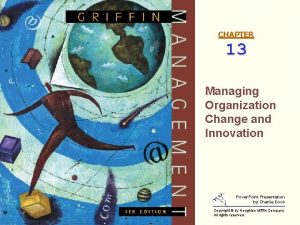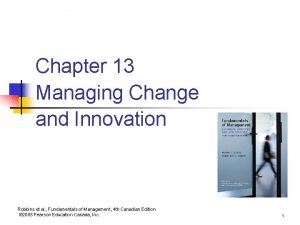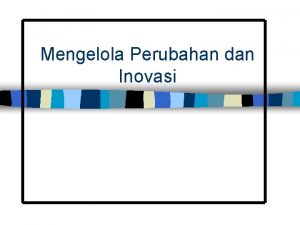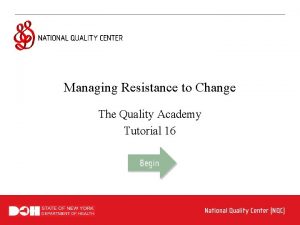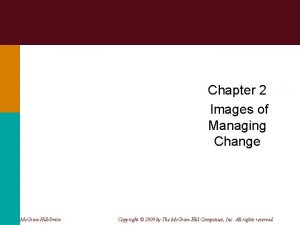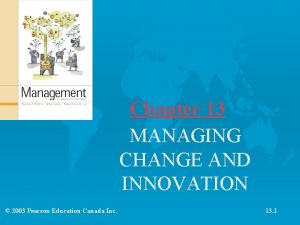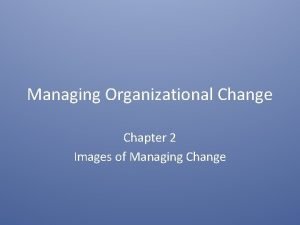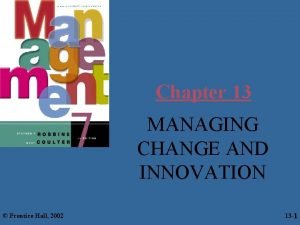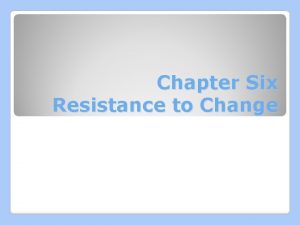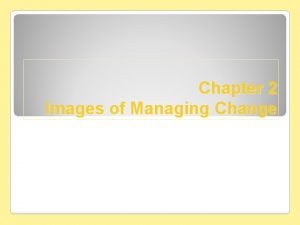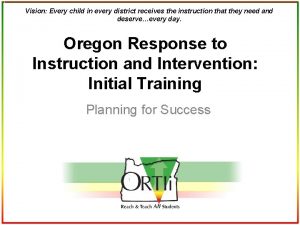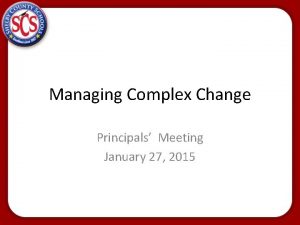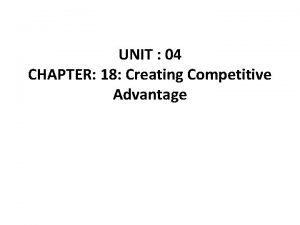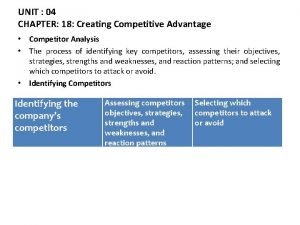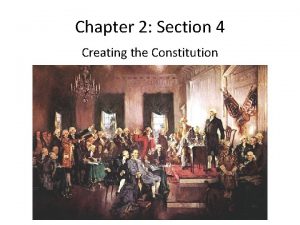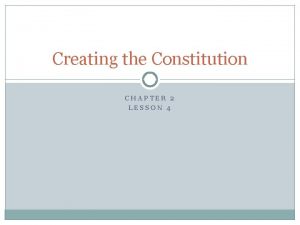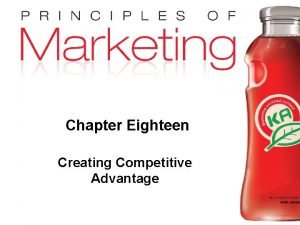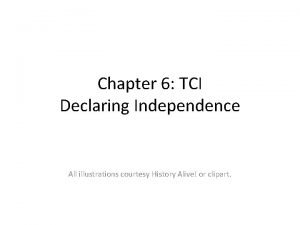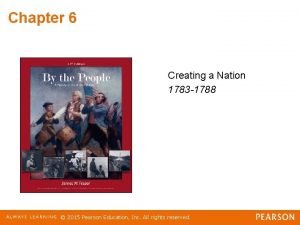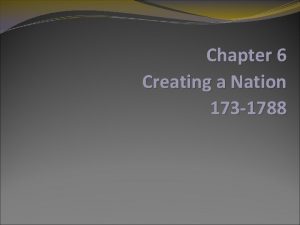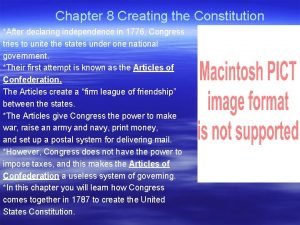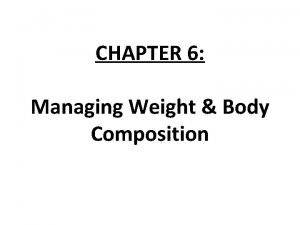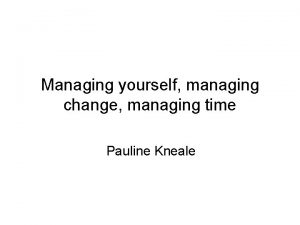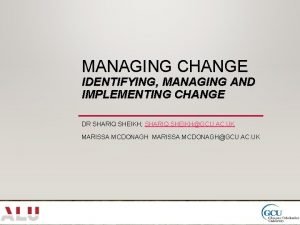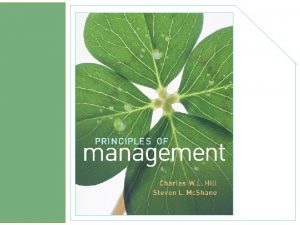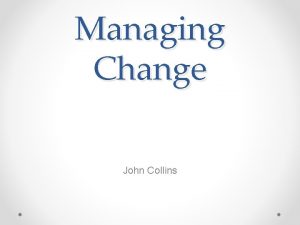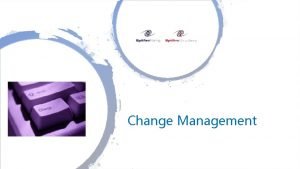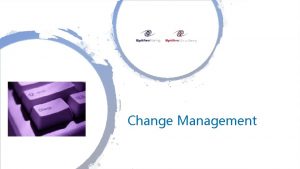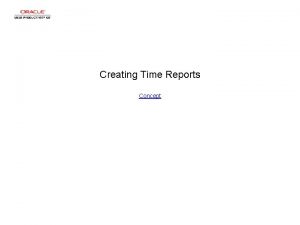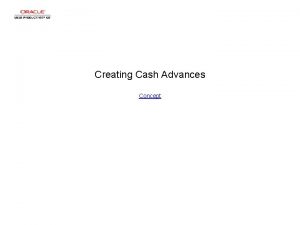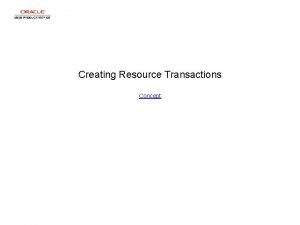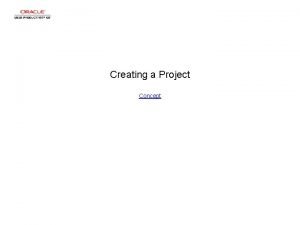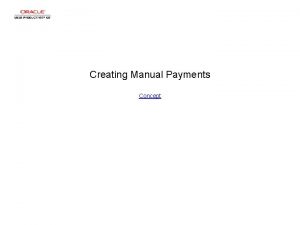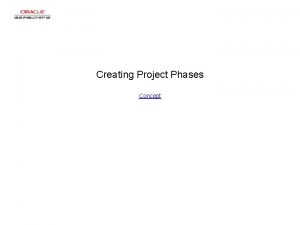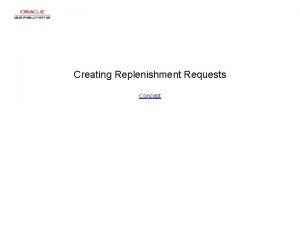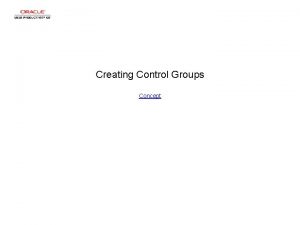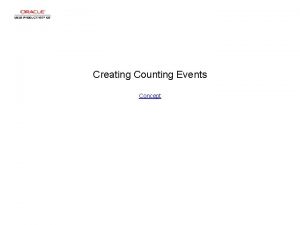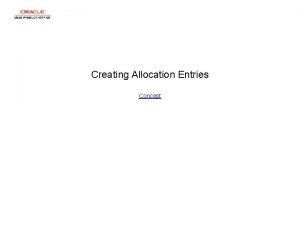Creating and Managing Change Chapter 18 Mc GrawHillIrwin


































- Slides: 34

Creating and Managing Change Chapter 18 Mc. Graw-Hill/Irwin Copyright © 2011 by the Mc. Graw-Hill Companies, Inc. All rights reserved.

Learning Objectives LO 1 Discuss what it takes to be world class LO 2 Describe how to manage change successfully LO 3 List tactics for creating a successful future 18 -2

Becoming World Class Being world class requires applying the best and latest knowledge and ideas and having the ability to operate at the highest standards of any place anywhere World-class companies create high-value products and earn superior profits over the long run The result is an organization capable of competing successfully on a global basis 18 -3

Sustainable, Great Features Great companies § Have strong core values § Are driven by goals § Change continuously § Focus on beating themselves, not on beating the competition 18 -4

The Genius of the And Genius of the and; organizational ambidexterity § Ability to achieve multiple objectives simultaneously. Examples § Purpose beyond profit and pragmatic pursuit of profit § Relatively fixed core values and vigorous change and movement § Clear vision and direction and experimentation 18 -5

Core Ideologies in Built-to-Last Companies Table 18. 1 18 -6

Organization Development Organization development (OD) § The system wide application of behavioral science knowledge to develop, improve, and reinforce the strategies, structures, and processes that lead to organizational effectiveness. 18 -7

Organization Development Strategic interventions, § helping organizations conduct mergers and acquisitions, change their strategies, and develop alliances Technostructural interventions § relating to organization structure and design, employee involvement, and work design 18 -8

Organization Development Human resources management interventions § Attracting good people, setting goals, and appraising and rewarding performance Human process interventions § Conflict resolution, team building, communication, and leadership. 18 -9

Achieving Greatness Strategy § focused on customers, continually fine-tuned based on marketplace changes, and clearly communicated to employees. Execution § good people, with decision-making authority on the front lines, doing quality work and cutting costs. 18 -10

Achieving Greatness Culture § one that motivates, empowers people to innovate, rewards people appropriately, entails strong values, challenges people, and provides a satisfying work environment 18 -11

Achieving Greatness Structure § making the organization easy to work in and easy to work with, characterized by cooperation and the exchange of information and knowledge throughout the organization 18 -12

Ex. 8. 1 Model of Change Sequence of Events Environmental Forces Monitor global competition, customers, competitors, and other factors. Internal Forces Consider plans, goals, company problems, and needs. Need for Change Evaluate problems and opportunities, define needed changes in technology, products, structure, and culture. © 2006 by South-Western, a division of Thomson Learning. All Initiate Change Facilitate search, creativity, idea champions, skunkworks, and idea incubators. Implement Change Use force-field analysis, tactics for overcoming resistance. 8 -13

Managing Change Shared leadership is crucial to the success of most change efforts—people must be not just supporters of change but also implementers Change agents § People who create change 18 -14

Motivating People to Change General reasons for resistance § § Inertia Timing Surprise Peer pressure 18 -15

Motivating People to Change-specific reasons for resistance § § Self-interest Misunderstanding Different assessments Management tactics 18 -16

Reasons for Resistance to Change Figure 18. 1 18 -17

Motivating People to Change Figure 18. 2 18 -18

A General Model for Managing Resistance Unfreezing § Realizing that current practices are inappropriate and that new behavior is necessary Performance gap § The difference between actual performance and desired performance. 18 -19

A General Model for Managing Resistance Moving § Instituting the change Refreezing § Strengthening the new behaviors that support the change 18 -20

Force-field Analysis Force-field analysis § An approach to implementing the unfreezing/ moving/refreezing model by identifying the forces that prevent people from changing and those that will drive people toward change 18 -21

Specific Approaches to Enlist Cooperation Education and communication Participation and involvement Facilitation and support Negotiation and rewards Manipulation and cooptation Explicit and implicit coercion 18 -22

Methods for Managing Resistance to Change Table 18. 2 18 -23

Methods for Managing Resistance to Change Table 18. 2 18 -24

Leading Change Figure 18. 3 18 -25

13 tips EDUCATE SYSTEM TEAMS EMPOWER PLAN RECOGNIZE TENSION TRAIN © 2006 by South-Western, a division of Thomson Learning. All 8 -26

13 TIPS RESEARCH EMOTIONS ANTICIPATE PROBLEMS INTELLECTUAL WHY IDEA CHAMPIONS LONG VIEW © 2006 by South-Western, a division of Thomson Learning. All 8 -27

Sources of Complacency Figure 18. 4 18 -28

Shaping the Future Reactive change § A response that occurs under pressure; problem driven change. Proactive change § A response that is initiated before a performance gap has occurred. 18 -29

Creating the Future Adapters § Companies that take the current industry structure and its evolution as givens, and choose where to compete Shapers § Companies that try to change the structure of their industries, creating a future competitive landscape of their own design. 18 -30

What Should You and Your Firm Do? Preserve old advantages or create new advantages? Lock in old markets or create new markets? Take the path of greatest familiarity or the path of greatest opportunity? Be only a benchmarker or a pathbreaker? 18 -31

What Should You and Your Firm Do? Place priority on short-term financial returns or on making a real, long-term impact? Do only what seems doable or what is difficult and worthwhile? Change what is or create what isn’t? Look to the past or live for the future? 18 -32

Adding Value, Personally Table 18. 3 18 -33

Level 5 Hierarchy Figure 18. 7 18 -34
 Managing change and innovation
Managing change and innovation The calm waters metaphor
The calm waters metaphor Organizational change and stress management
Organizational change and stress management Managing change and innovation
Managing change and innovation Managing complex change
Managing complex change Change management picture
Change management picture Contemporary issues in managing change
Contemporary issues in managing change Six images of change management
Six images of change management Contemporary issues in managing change
Contemporary issues in managing change Six images of managing change
Six images of managing change Managing change images
Managing change images Managing complex change
Managing complex change Ambrose managing complex change
Ambrose managing complex change Value creation strategy
Value creation strategy Chapter 18 creating competitive advantage
Chapter 18 creating competitive advantage Chapter 2 section 4 creating the constitution
Chapter 2 section 4 creating the constitution Lesson 4 creating the constitution answers
Lesson 4 creating the constitution answers Chapter 18 creating competitive advantage
Chapter 18 creating competitive advantage Tci chapter 8 - creating the constitution answer key
Tci chapter 8 - creating the constitution answer key Chapter 6 creating a nation
Chapter 6 creating a nation Chapter 6 creating a nation
Chapter 6 creating a nation Chapter 18 creating competitive advantage
Chapter 18 creating competitive advantage Chapter 8 creating the constitution
Chapter 8 creating the constitution Examples of chemical changes
Examples of chemical changes Absolute change and relative change formula
Absolute change and relative change formula Difference between chemical and physical change
Difference between chemical and physical change Change in supply and change in quantity supplied
Change in supply and change in quantity supplied Physical and chemical changes examples
Physical and chemical changes examples Rocks change due to temperature and pressure change
Rocks change due to temperature and pressure change Physical change and chemical change venn diagram
Physical change and chemical change venn diagram First and second order change in education
First and second order change in education Creating and interpreting graphs and tables
Creating and interpreting graphs and tables Chapter 8 managing stress and anxiety
Chapter 8 managing stress and anxiety Chapter 4 managing stress and coping with loss
Chapter 4 managing stress and coping with loss Chapter 6 managing weight and body composition
Chapter 6 managing weight and body composition
